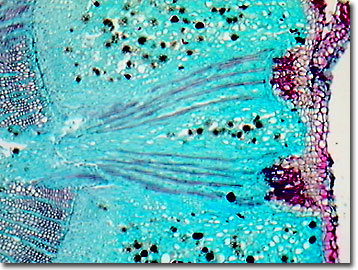Brightfield Digital Image Gallery
Druse Crystals
Plants, as rooted, sessile life forms have evolved intricate mechanisms for avoiding predation (herbivory), such as thorns, toxic and repellant chemicals, and even guardian commensal organisms such as valiant ant colonies. Many plant species produce crystal inclusions as a defense mechanism against herbivory.

Most crystalline aggregations, or druse crystals, found in plants are made of calcium oxalate, which is the compound that most frequently forms kidney stones in humans. If ingested, the material is poisonous to humans as well as to most animals. Druse crystals are usually globular or star-like in shape, but calcium oxalate may form as needles or spear-shaped crystals (raphides). Any of these forms is thought to deter herbivory, and a number of species of plants are considered poisonous due to the high calcium oxalate content. The crystals, whether druse or raphides in form, also allow the plants to store excess calcium in the form of calcium oxalate so that the calcium can be remobilized if needed in the process of calcium regulation.
Contributing Authors
Cynthia D. Kelly, Thomas J. Fellers and Michael W. Davidson - National High Magnetic Field Laboratory, 1800 East Paul Dirac Dr., The Florida State University, Tallahassee, Florida, 32310.
BACK TO THE BRIGHTFIELD IMAGE GALLERY
BACK TO THE DIGITAL IMAGE GALLERIES
Questions or comments? Send us an email.
© 1995-2025 by Michael W. Davidson and The Florida State University. All Rights Reserved. No images, graphics, software, scripts, or applets may be reproduced or used in any manner without permission from the copyright holders. Use of this website means you agree to all of the Legal Terms and Conditions set forth by the owners.
This website is maintained by our
Graphics & Web Programming Team
in collaboration with Optical Microscopy at the
National High Magnetic Field Laboratory.
Last Modification Friday, Nov 13, 2015 at 01:19 PM
Access Count Since September 17, 2002: 40254
Visit the website of our partner in introductory microscopy education:
|
|
